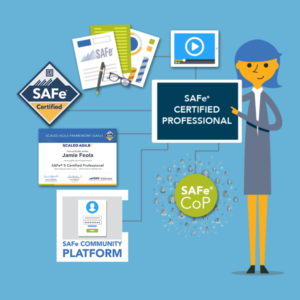Change agents help organizations, or part of them, to transform how they operate. They are focused on people, their interactions, desires and behaviors, and they promote, enable and support changes that lead to success. To be a good change agent, someone needs to possess many qualities – he needs to know his terrain well, be very knowledgeable, embrace values and mindset of the ‘new vision’ and be able to inspire, motivate and influence everyone involved, especially key individuals within the organization. He must remain visible and listen to his team all the time, and remain sensitive to their needs.

Changing the development practices and behavior of an organization is everything but simple. According to John P. Kotter, path to successful transformation should begin with creation of a ‘sufficiently powerful guiding coalition’. Such a coalition should involve leaders, who can set the vision, show the way, and remove impediments, and practitioners, managers, and change agents who know how to implement specific process changes and are able to make fast, intelligent decisions. At the same time, change agents need to be experts in their field and the organization needs to own enough credibility to be taken seriously.
Within SAFe® (Scaled Agile Framework for Enterprises), the role of change agents belongs to Certified SAFe® Program Consultants (SPCs). SPCs come from different internal and external roles, such as business and technology leaders, managers (project, program or portfolio), process leads, architects, analysts and consultants, and play a critical role in successfully implementing SAFe. It is important to note, that for the transformation to be successful, the enterprise should not count on single SPC, but instead engage multiple SPCs. To successfully drive and sustain the implementation, SAFe suggests having 3-5 SPCs per 100 development practitioners.
Responsibilities of change agent within SAFe®
As knowledgeable change agents, SPCs participate in many of the activities identified in the 12 critical moves described in the SAFe Implementation Roadmap. Specifically, they assist with:
Reaching the tipping point – They communicate the business need, urgency, and vision for change.
Training executives, managers, and leaders – They socialize the new concepts and provide orientation and overview training. SPCs teach Leading SAFe and facilitate modules of the Leading in the Digital Age series for leaders, managers, and stakeholders.
Establishing a Lean-Agile Center of Excellence (LACE) – SPCs assist the LACE with building and executing the transformation backlog.
Identifying Value Streams and Agile Release Trains (ARTs) – Working with stakeholders to understand the flow of value, SPCs facilitate the identification of Operational Value Streams, Development Value Streams and ARTs to find those that are the most opportunistic for launch.
Creating the implementation plan – SPCs participate in creating a plan for the rollout, communicate upcoming changes, and establish metrics.
Preparing for the ART launch – SPCs help the LACE plan and prepare for the ART launch. They coach leadership and help facilitate the creation of new Agile Teams. They also train or source training of executives, leaders, Agile teams, and specialty roles—such as Product Owner, Product Manager, Scrum Master, and Release Train Engineer (RTE). They also assess and evolve launch and backlog readiness.
Training teams and launching the ART – SPCs often directly plan and execute ‘quickstart’ or other rollout strategies. They train or source training for teams and participate in initial, critical events like Program Increment (PI) Planning and Inspect and Adapt (I&A). SPCs help establish the ART launch date and calendar for ART and Team events.
Coaching ART execution – The SPCs coach leaders and stakeholders to build and maintain the Vision, Roadmap, and Program Backlogs. They coach teams, Product Owners, Product Managers, Architects, and RTEs. They guide the shift from project-to-product with a focus on Customer Centricity and Design Thinking as part of Agile Product Delivery. They also participate in Scrum of Scrums and System Demo, facilitate I&A and follow-up on improvement items. Finally, they help teams establish a DevOps culture and mindset, the Continuous Delivery Pipeline, infrastructure, and associated Agile technical practices.
Launching more ARTs and value streams – SPCs work to enable new change agents to increase organizational capacity to support new value streams, start more ARTs, and expand the reach of the LACE. They communicate progress and highlight early accomplishments.
Extending to the portfolio – Once Lean-Agile practices gain momentum, SPCs can socialize and drive those practices to the portfolio level, including Portfolio Vision, Lean Budgets using Participatory Budgeting and Guardrails, Lean Portfolio Management, leaner approaches to CapEx and OpEx, and Agile Contracts. They also communicate the value of Strategic Themes. (Note that some organizations may opt to implement LPM much earlier in their SAFe transformation.)
Accelerating – An enterprise’s SAFe journey doesn’t end with the launching of trains and the adoption of Lean Portfolio Management. SPCs have expert mastery of the seven competencies of the Lean Enterprise and how they contribute to achieving Business Agility. They are proficient in using the assessments described in Measure & Grow to help organizations understand where they are on the path to business agility. SPCs can also help develop the action plans that the enterprise to grow in each of the 21 dimensions across the SAFe competencies (Source: Scaled Agile, Inc.)
Key to success is the right training!
Taking a role of a change agent within SAFe is a complex task. SPCs must be properly trained and possess all necessary skills and tools needed to accomplish their mission. They should be able to coach, teach and support others in adopting new ways and lead the transformation by example.
 The best way to achieve this is to take the Implementing SAFe with SAFe® Program Consultant (SPC) certification class. This four-day course prepares SPCs to become the change agents who lead the transformation. Attendees learn how to effectively apply the principles and practices of SAFe and organize, train, and coach Agile teams.
The best way to achieve this is to take the Implementing SAFe with SAFe® Program Consultant (SPC) certification class. This four-day course prepares SPCs to become the change agents who lead the transformation. Attendees learn how to effectively apply the principles and practices of SAFe and organize, train, and coach Agile teams.
They also learn how to identify value streams, identify and launch ARTs, and help build and manage an Agile portfolio.
Scaling Lean-Agile across the enterprise also requires training all the people who do the work. To make this practical and cost-effective, Scaled Agile, Inc. supports a train the trainer, fan-out model, licensing SPCs to teach SAFe courses that support the other key roles in the implementation. This provides an affordable training strategy and supplies the trainers needed to achieve the mission of company-wide change (Source: Scaled Agile, Inc).





